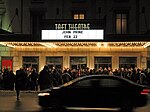Taft Museum of Art
1927 establishments in OhioArt museums and galleries in OhioArt museums established in 1927Arts in CincinnatiFormer houses in Ohio ... and 10 more
Former private collections in the United StatesHouses completed in 1820Houses in CincinnatiHouses on the National Register of Historic Places in OhioIndividually listed contributing properties to historic districts on the National Register in OhioMuseums in CincinnatiNRHP infobox with nocatNational Historic Landmarks in OhioNational Register of Historic Places in CincinnatiTaft family

The Taft Museum of Art is a fine art collection in Cincinnati, Ohio. It occupies the 200-year-old historic house at 316 Pike Street. The house – the oldest domestic wooden structure in downtown Cincinnati – was built about 1820 and housed several prominent Cincinnatians, including Martin Baum, Nicholas Longworth, David Sinton, Anna Sinton Taft and Charles Phelps Taft. It is on the National Register of Historic Places listings, and is a contributing property to the Lytle Park Historic District.
Excerpt from the Wikipedia article Taft Museum of Art (License: CC BY-SA 3.0, Authors, Images).Taft Museum of Art
Butler Street, Cincinnati Central Business District
Geographical coordinates (GPS) Address Nearby Places Show on map
Geographical coordinates (GPS)
| Latitude | Longitude |
|---|---|
| N 39.1025 ° | E -84.503333333333 ° |
Address
Park Place at Lytle
Butler Street
45202 Cincinnati, Central Business District
Ohio, United States
Open on Google Maps







